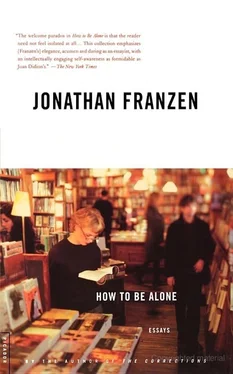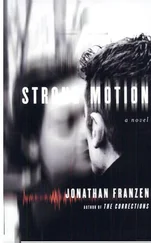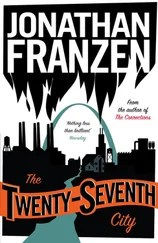“Being alive versus having to die,” I said. “Exactly,” Heath said. “Of course, there is a certain predictability to literature’s unpredictability. It’s the one thing that all substantive works have in common. And that predictability is what readers tell me they hang on to — a sense of having company in this great human enterprise, in the continuity, in the persistence, of the great conflicts.”
Flying back from Palo Alto in an enforced transition zone crewed by the employee-owners of TWA, I declined the headphones for The Brady Bunch Movie and a special one-hour segment on the E! channel, but I found myself watching any-way. Without sound, the segment on E! became an exposé of the hydraulics of insincere smiles. It brought me an epiphany of inauthenticity, made me hunger for the unforced emotion of a literature that isn’t trying to sell me anything. I had open on my lap Janet Frame’s novel of a mental hospital, Faces in the Water: uningratiating but strangely pertinent sentences on which my eyes would not stick until, after two and a half hours, the silent screen in front of me finally went blank.
Poor Noeline, who was waiting for Dr. Howell to propose to her although the only words he had ever spoken to her were How are you? Do you know where you are? Do you know why you are here? — phrases which ordinarily would be hard to interpret as evidence of affection. But when you are sick you find in yourself a new field of perception where you make a harvest of interpretations which then provides you with your daily bread, your only food. So that when Dr. Howell finally married the occupational therapist, Noeline was taken to the disturbed ward.
Expecting a novel to bear the weight of our whole disturbed society — to help solve our contemporary problems — seems to me a peculiarly American delusion. To write sentences of such authenticity that refuge can be taken in them: isn’t this enough? Isn’t it a lot?
As recently as forty years ago, when the publication of Hemingway’s The Old Man and the Sea was a national event, movies and radio were still considered “low” entertainments. In the Fifties and Sixties, when movies became “film” and demanded to be taken seriously, TV became the new low entertainment. Finally, in the Seventies, with the Watergate hearings and All in the Family , television, too, made itself an essential part of cultural literacy. The educated single New Yorker who in 1945 read twenty-five serious novels in a year today has time for maybe five. As the modeled-habit layer of the novel’s audience peels away, what’s left is mainly the hard core of resistant readers, who read because they must.
That hard core is a very small prize to be divided among a very large number of working novelists. To make a sustainable living, a writer must also be on the five-book lists of a whole lot of modeled-habit readers. Every year, in expectation of this jackpot, a handful of good novelists get six-and even seven-figure advances (thus providing ammunition for cheery souls of the “American literature is booming!” variety), and a few of them actually hit the charts. E. Annie Proulx’s The Shipping News has sold nearly a million copies in the last two years; the hardcover 1994 literary best-seller The Crossing , by Cor mac McCarthy, came in at number 51 on the Publishers Weekly annual best-seller list. (Number 50 was Scar Trek: AU Good Things .)
The persistence of a market for literary fiction exerts a useful discipline on writers, reminding us of our duty to entertain. But if the academy is a rock to ambitious novelists, then the nature of the modern American market — its triage of artists into Superstars, Stars, and Nobodies; its clear-eyed recognition that nothing moves a product like a personality — is a hard place indeed. Amy Tan, the young novelist, sings backup in the Rock Bottom Remainders, the pro-literacy rock-and-roll group. Michael Chabon, an even younger novelist, gives readers his e-mail address on the dust jacket of Wonder Boys , his novel of a novelist in the academy. Donna Tartt (whose first book was likewise set in the academy) dons a suit of armor and poses as Joan of Arc in the New York Times for Halloween. The subject of Mark Leyner’s fiction is the self-promotion of Mark Leyner, the young writer; he’s been on Letterman twice. Rick Moody, the young author of The Ice Storm , has written a comic strip for Details magazine in which a young author named Rick Moody hires a body double to do his bookstore readings for him. In the strip, Moody is making art of the torment that many young novelists feel at the pressure to market the innately private experience of reading by means of a public persona — on book tours, on radio talk shows, on Barnes & Noble shopping bags and coffee mugs.
The writer for whom nothing matters but the printed word is, ipso facto, an untelevisable personality, and it’s instructive to recall how many of our critically esteemed older novelists have chosen, in a country where publicity is otherwise sought like the Grail, to guard their privacy. Roth, McCarthy, Don DeLillo, William Gaddis, Anne Tyler, J. D. Salinger, Thomas Pynchon, Cynthia Ozick, and Denis Johnson all give few or no interviews, do little if any teaching or touring, and in some cases decline even to be photographed. Various Heathian dramas of social isolation are no doubt being played out here. But for some of these writers, reticence is integral to their artistic creed.
In Gaddis’s first novel, The Recognitions (1955), a stand-in for the author cries; “What is it they want from a man that they didn’t get from his work? What do they expect? What is there left of him when he’s done his work? What’s any artist, but the dregs of his work? the human shambles that follows it around.” Postwar novelists like Gaddis and Pynchon and postwar artists like Robert Frank answered these questions very differently than Norman Mailer and Andy Warhol did. In 1955, before television had even supplanted radio as the regnant medium, Gaddis recognized that no matter how attractively subversive self-promotion may seem in the short run, the artist who’s really serious about resisting a culture of inauthentic mass-marketed image must resist becoming an image himself, even at the price of certain obscurity.
For a long time, trying to follow Gaddis’s example, I took a hard line on letting my work speak for itself. I refused to teach, to review for the Times, to write about writing, to go to pub-industry parties. To speak extra-novelistically in an age of personalities seemed to me a betrayal; it implied a lack of faith in fiction’s adequacy as communication and self-expression, and so helped, I believed, to accelerate the public flight from the imagined to the literal. I had a cosmology of silent heroes and gregarious traitors.
Silence, however, is a useful statement only if someone, somewhere, expects your voice to be loud. Silence in the Nineties seemed only to guarantee that I would be alone. And eventually it dawned on me that the despair I felt about the novel was less the result of my obsolescence than of my isolation. Depression presents itself as a realism regarding the rottenness of the world in general and the rottenness of your life in particular. But the realism is merely a mask for depression’s actual essence, which is an overwhelming estrangement from humanity. The more persuaded you are of your unique access to the rottenness, the more afraid you become of engaging with the world; and the less you engage with the world, the more perfidiously happy-faced the rest of humanity seems for continuing to engage with it.
Writers and readers have always been prone to this estrangement. Communion with the virtual community of print requires solitude, after all. But the estrangement becomes much more profound, urgent, and dangerous when that virtual community is no longer densely populated and heavily trafficked; when the saving continuity of literature itself is under electronic and academic assault; when your alienation becomes generic, rather than individual, and the business pages seem to report on the world’s conspiracy to grandfather not only you but all your kind, and the price of silence seems no longer to be obscurity but outright oblivion.
Читать дальше
Конец ознакомительного отрывка
Купить книгу












